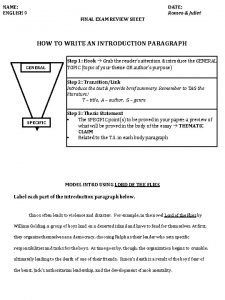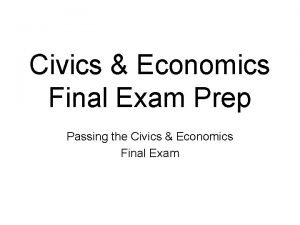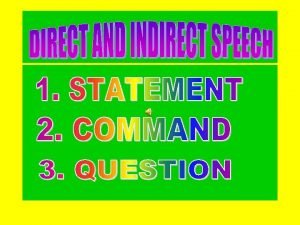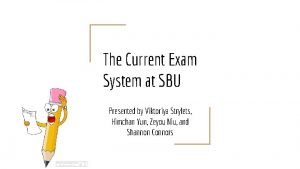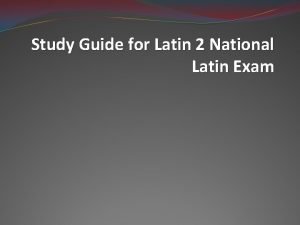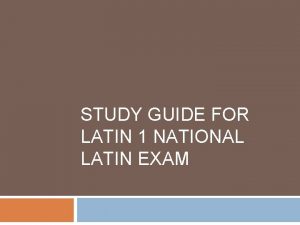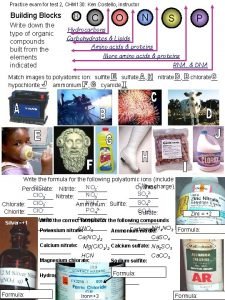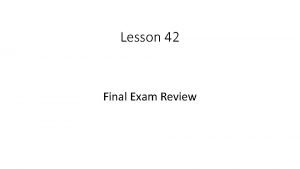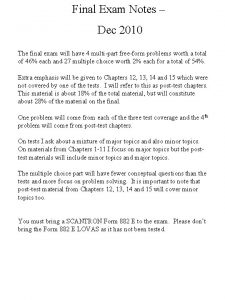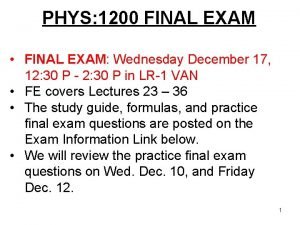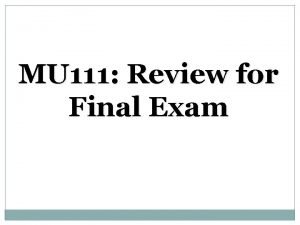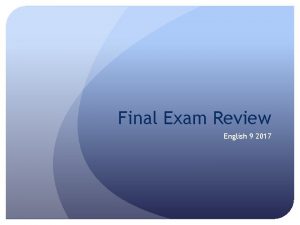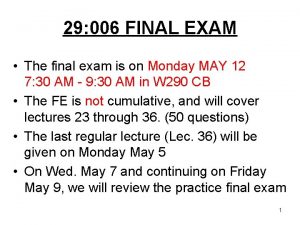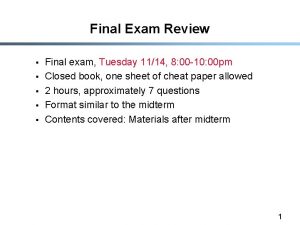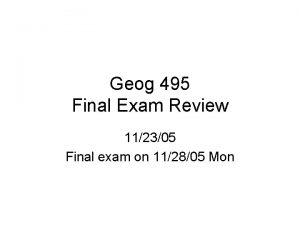FINAL EXAM NOTES STUDY THESE FOR FINAL TEST



































- Slides: 35

FINAL EXAM NOTES STUDY THESE FOR FINAL TEST

What is Economics? • There are many definitions for the term Economics. Let us examine one: • Economics is the study of how people use scarce resources in an economy to meet their unlimited demands. • Economics is primarily concerned with the use of resources

Understanding the Economic Environment of Personal Finance • Tracking at least two statistics may help understand the direction of the economy: • Gross Domestic Product (GDP) -- the value of all goods and services produced by workers and capital located in the United States, regardless of ownership. • Gross domestic product that has been adjusted for inflation is called real GDP • Consumer Price Index (CPI) – measures the average change over time in the prices paid by urban consumers for a market basket of consumer goods and services. • Inflation-- a steady rise in the general level of prices. • When inflation occurs, the purchasing power of the dollar goes down • Deflation -- falling prices.

Supply & Demand • According to the law of demand, when the price of an item goes up, the quantity demanded falls. • According to the law of supply, higher prices prompt producers to produce more. • Prices on goods and services are determined by demand supply • In perfect competition, prices are controlled by supply and demand

SCARCITY Scarcity is the condition in which human wants are forever greater than the available supply of time, goods, and resources. • Scarcity always exists because there is not enough of all goods and services to satisfy everyone’s needs and wants.

What is risk? • Risk is the possibility of suffering harm or loss; danger.

Stocks When you buy a share of stock, you are taking a share of ownership in a company. • Collectively, the company is owned by all the shareholders, and each share represents a claim on assets and earnings. • How does an investor make money from an investment? • • The price for which a stock is bought and sold in the marketplace is called the Market Value • Yahoo. com

Stocks • Usually considered the best long term investments • Dow Jones: • A weighted price measure of stock in 30 large corporations meant to represent the U. S. economy. • Invest in What You Know

Attracting Stock Investors with Dividends • Companies try to persuade potential investors by offering them the promise of dividend payments • A dividend is the distribution of a portion of a company’s earnings to their shareholders • Using dividends previously earned on a stock to buy more shares is called dividend reinvestment.

Diversification When investing, the best way to balance risks is to “diversify” investments. • What does diversify mean? • Not investing in one area. IE: putting all $$ into stocks • Don’t put all your eggs in 1 basket. •

Tax Deferred What are taxes? What does “defer” mean? • • • “Delay” Tax Deferred means that you pay taxes only when you sell your investment. • • IE: People saving for retirement usually do this.

RULE OF 72 • The Rule of 72 is a simplified way to determine how long an investment will take to double, given a fixed annual rate of interest. • By dividing 72 by the annual rate of return, investors can get a rough estimate of how many years it will take for the initial investment to duplicate itself. • For example, the rule of 72 states that $1 invested at 10% would take 7. 2 years ((72/10) = 7. 2) to turn into $2.

Rule of 72 72 Interest Rate 72 Years Needed to Double Investment 3 -H = Years Needed to Double Investment = Interest Rate Required

Bonds • Bonds are fancy IOUs • Highest rating is AAA • Bonds: A loan from an investor to a corporation or a government entity that makes fixed interest payments for a set time period and ultimately pays back the principal in full. • When you buy a bond, you are loaning your money for a certain period of time (with interest) to someone (company) • For example if you own 1 bond from Mc. Donalds, then Mc. Donalds owes you money sometime in the future. • Companies issue bonds to help finance (get $$) their business operations or investments. • Apple issued bonds to the public to investment in.

Background on Bonds • Par value: for a bond, its face value, or the amount returned to the investor at the maturity date when a bond is due • Most bonds have maturities between 10– 30 years • When a bond issuer cannot meet the interest and/or principal payments a bond default has occurred

Mutual Funds • A mutual fund pools money from hundreds and thousands of investors to construct a portfolio of stocks, bonds, real estate, or other securities, according to its charter. • Each investor in the fund gets a slice of the total pie.

ERISA • The Employee Retirement Income Security Act of 1974 (ERISA) is a federal law that establishes minimum standards for pension plans in private industry and provides for extensive rules on the federal income tax effects of transactions associated with employee benefit plans. • ERISA was enacted to protect the interests of employee benefit plan participants

What is Retirement? The period of a person's life during which he/she is no longer working, or the commencement of that period. The standard age for retirement in the United States is considered 65, although many individuals choose to retire earlier or later due to personal or financial reasons. After retirement, an individual's needs are usually funded by your savings.

How much money will you need when you retire? • Experts say you may need 60% to 80% of your final working year’s salary each year during retirement. • Many people stay healthy and active for 20 years or more after they retire. • If you start planning and investing soon enough, you can spend those years enjoying yourself instead of worrying about paying the bills. • A common mistaken belief about retirement is the think they will have plenty of time to start saving for retirement

Eligibility requirements to receive Social Security: • You must be a United States citizen to be eligible for Social Security benefits. • You must “work” and put money towards Social Security benefits for a period of 10 years before you can collect Social Security benefits upon retirement. Social Security retirement benefits are: taxable in some states

ERISA • The Employee Retirement Income Security Act of 1974 (ERISA) is a federal law that establishes minimum standards for pension plans in private industry and provides for extensive rules on the federal income tax effects of transactions associated with employee benefit plans. • ERISA was enacted to protect the interests of employee benefit plan participants

Types Pension: A sum of money paid regularly as a retirement benefit FROM A COMPANY. Defined Benefit Plan: A pension plan in which the amount of benefits paid to an employee after retirement is fixed in advance in accordance with a formula given in the plan. Note: The amount contributed is fixed, and so is the benefit. Defined Contribution Plan: A pension plan wherein a certain amount or percentage of money is set aside each year (by either the company and/or the employee) for the benefit of the employee. There are restrictions as to when and how you can withdraw these funds without penalties. Note: There is no way to know how much the plan will ultimately give the employee upon retiring, because only the contribution, not the benefit, is defined. EX: 401(k), 403(b) Traditional IRA & Roth IRAs (Individual Retirement Account)

What is 401(k) Plan? 401(k): A type of defined contribution retirement account for employees of business funded through pre-tax payroll deductions. Catch up contributions- over age 50 Employers will often match 401(k) contributions. I never like to walk away from free money.

What Is a 403(b) Plan? A 403(b) plan is a type of taxdeferred retirement savings program that is available to employees of public schools, employees of certain non-profit entities, and some members of the clergy.

What is an IRA? • An Individual Retirement Account (IRA) is a form of "individual retirement plan", provided by many financial institutions, that provides tax advantages for retirement savings in the United States.

Types of IRAs Traditional IRA Contributions may be deductible on your federal income tax return There are no income limitations for making contributions. However, deductibility is affected by income amounts.

Roth IRA For federal income tax return purposes, contributions are not tax-deductible, but can be withdrawn any time — tax-free Earnings are tax-free for qualified distributions A Roth IRA differs from a traditional IRA in that contributions are taxed but earnings are not. DOES NOT Allow for contributions to be deductible on your federal income tax return

Credit Card REVIEW All of the following are danger signs that you are overextending your credit except a. your credit cards are all near the limit. b. your credit rating is rising. c. you skip some payments in order to make other payments. d. you often pay one credit card by using another credit card. Which of the following would be difficult to make without a credit card? A. purchasing a car B buying a house C reserving a hotel room D. buying groceries

Reason for taxes Your city, state and country collect taxes to pay for services they provide, as well as operating costs. In some cases, the services may not apply to you, but you are still required to pay for them as being part of the greater community. For example, people that do not have children are still required to pay taxes for teachers and schools. They are really paying to keep their society stable. 4/15 - previous years taxes must be filed by this date (can get extension) In the United States, the responsibility for filing a tax return rests with the individual. This defines the concept of voluntary compliance. • The IRS has the legal right to audit your tax returns and supporting records for 3 years from the date of filing.

W-4 • Tells government how much tax to withhold from your paycheck • This form ask for your name, address, Social Security number, marital status, and the number of exemptions you claim for income tax purposes. • LINE 5: TOTAL NUMBER OF ALLOWANCES (amount to be withheld for taxes) • The lower the number, the higher the amount of taxes withheld. • Differs if married or single • The more allowances you claim, the less tax you will have withheld from your paycheck.

W-2 • Earnings summary for work in the previous year. • Usually received by January 31. • Needed to file taxes by April 15 (unless filing for extension or the date lands on weekend).

When a check is returned to the payee’s bank due to insufficient funds, the check is said to have Bounced A request that a bank not honor a specific check is called a stop payment

Savings ALL Savings accounts protected by the FDIC are protected from loss for up to $250, 000

TYPES OF ENDORSEMENTS (CON’T) • SPECIAL ENDORSEMENT - This method allows you to sign your check over to someone else (a third party) who may then deposit it or cash it. Write "Pay to the order of" and then the name of the person you are giving the check to. Then, as above, sign your name underneath. Now you can give your check to that individual. • • ENDORSE CHECK HERE • Pay to the order of • Lisa Reynolds • John Smith

ENDORSEMENT EXERCISE PRACTICE: Which endorsement is used when the payee writes the words “For Deposit Only” above the endorsement? a)blank b)restrictive c)special d)Joint • A check is written to Taylor Thomas. On the back of the check, Taylor writes “Pay to the order of Rose Dryer, ” then signs her name. What kind of endorsement is this? a)blank b)restrictive c)special d)Joint
 World geography spring final review
World geography spring final review U.s. history semester 1 final exam
U.s. history semester 1 final exam Physical science final exam review
Physical science final exam review Romeo and juliet exam review
Romeo and juliet exam review Earth science final exam review
Earth science final exam review Civics and economics final exam study guide
Civics and economics final exam study guide World history final exam study guide
World history final exam study guide Physics semester 1 final exam study guide answers
Physics semester 1 final exam study guide answers Us history semester 1 final exam study guide answers
Us history semester 1 final exam study guide answers Zoology final exam study guide
Zoology final exam study guide Pols 1101 final exam
Pols 1101 final exam Us history semester 1 final exam study guide answers
Us history semester 1 final exam study guide answers My father asked us
My father asked us Hbs eoc study guide
Hbs eoc study guide English 9 final exam
English 9 final exam Spanish 2 review
Spanish 2 review World history spring final exam review answers
World history spring final exam review answers Web design final exam
Web design final exam Sbu finals schedule
Sbu finals schedule Latin 2 final exam
Latin 2 final exam National latin exam practice quiz
National latin exam practice quiz Street law final exam
Street law final exam Spanish 1 semester 1 final exam answer key
Spanish 1 semester 1 final exam answer key English 2 semester exam
English 2 semester exam What is the answer
What is the answer Pltw human body systems final exam review
Pltw human body systems final exam review Realidades 2 final exam
Realidades 2 final exam Chemistry 151 final exam
Chemistry 151 final exam Chem 130 final exam
Chem 130 final exam Poe final exam
Poe final exam Mat1033 final exam
Mat1033 final exam 42 final exam
42 final exam Aice general paper final exam
Aice general paper final exam Ied final exam
Ied final exam Human resource management question paper
Human resource management question paper Hospitality and tourism final exam
Hospitality and tourism final exam



